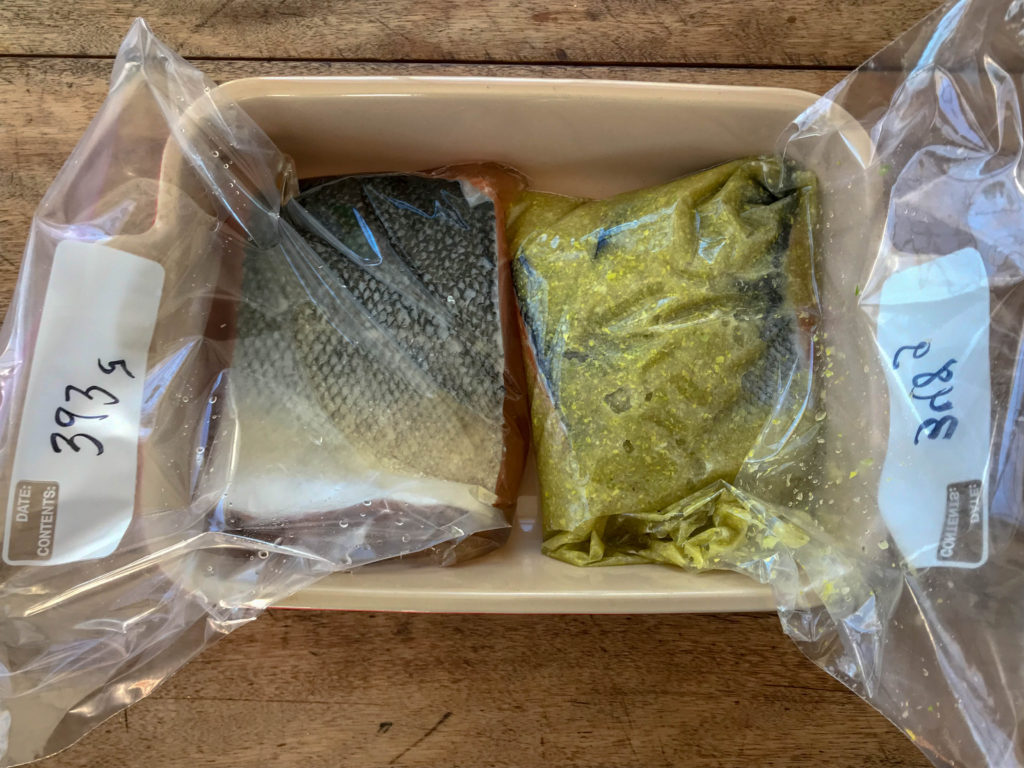
It’s a serious, if Monty Python-ish question: How wet would you like your fish?
There are a zillion recipes out there for curing fish both dry (with salt and, usually, some sugar and spices) or wet (in some kind of brine). They have huge variations in the amount of time spent curing, on whether or not you should weigh down the fish, turn it, drain it, how much salt to use, and so on. But the bottom line is, how much moisture do you want in the finished product? Answer that precisely and the rest is pure mechanics.
What got me thinking about this was a hands-off, three-day gravlax recipe in a recent Bon Appetit. The pictures were great, of course, and as I read through the recipe I went through my own mental dry-cured checklist:
Grated citrus rind – Damn, I thought I was the only one that knew to do that.
High salt-to-fish ratio – OK, whatever. Extra salt doesn’t matter after a certain point.
High sugar to salt ratio, almost half and half – Maybe a little sweet.
Not a lot of black pepper – So, sweet and citrus-y rather than savory.
Wrap the fish in parchment, then plastic – Goodness. How will wet paper help?
Heavy weight for three solid days – I like it.
No draining or turning – Seriously? No draining at all?
The issue at hand is that salt, weight, time and a little air-drying will squish around 10% of the water out of a fish, which puts it in gravlax territory. But leaving the fish in salty water is, effectively, putting it in a brine. Fish lolling in brine will puff up by around 5% after just one hour. Wouldn’t salting a fish without draining it create a kind of fish-powered water pump?
Once or twice in my cured fish career, I have left salmon sitting too long in the juices that flow out after it’s salted. If you wait much longer than about 12 hours before draining, the juices start to reabsorb, and the result is pretty puckery, especially below the waterline. The salinity in the fish will redistribute in another day or two, but it will still be a very salty product – not inedible, IMHO, but nothing I’d like to serve to my cardiologist.
Where did this mysterious, no-drain recipe come from? There being nothing new under the internet sun, a quick check revealed attributions of parchment paper, heavy weight, and a no-drain approach to gravlax in the culinary work of Mario Batali, Umami Girl, and the honest-to-God CIA (Culinary Institute of America, of course). So what gives?
Maybe the parchment paper soaks up a lot of the brine and doesn’t give it back, or has some other mystic chemical properties? I also noticed that these paper-wrapped salmon recipes also specified use of a sheet pan. If the fish liquid has room to spread out and evaporate rather than accumulate, could that be the secret?
I decided not to find out.
I mean really, Eaters. How hard is it to drain fish? I like draining fish. If I set up some gravlax in the AM or PM, by that PM or AM I am itching to take a look at it, and pour off any excess fluids before I either go to bed or start the day. In fact, in my fridge at this very moment and sharing a common drainage in the same large baking dish, is a mixture of two pounds of classic pastrami-cured salmon and an extra experimental pound cured with soy, mirin, garlic and ginger. I drained it of about a quarter inch of Jewish-Japanese fish juice this morning, after its first twelve hours under a foil-wrapped brick. A finger dipped in the brine tasted wonderfully of licorice (from the fennel in the pastrami cure and a dab of aquavit) and ginger.
I wondered: might one make a savory gingerbread with caraway seeds? A rice bowl with soy-cured salmon, wild rice and fennel?
Why would I not want to drain my fish? Not only does it keep things clean and salted the way I expect, it’s a perfect time to dream about the culinary future. Kind of the reverse of the reverie I experience when I take out the garbage, which I call Remembrance of Things Passed.
If this sounds a bit out there, Eaters, perhaps you can profit by my harmless eccentricity. What follows are some general kitchen science observations recorded in the pursuit of dry-cured salmon. But even before we get into anything remotely recipe-like, here is Poppa Larry’s cold fish water extraction rubric:
- Fish with a dry-cured feel – concentrated flavor, easy to make super-thin slices that hold together – starts at around 5% moisture loss. Before that, IMHO, it’s sushi. My ideal is a fish shrunk by around 10%. Some highly regarded commercial producers pull out 15 or 20%, but I suspect they’re starting with a fresher, moister product.
- The rubric goes like this: after a day in the fridge, draped with saran and weighed down with a brick, the fish will lose around 6.5% of its weight. The brick is only responsible for half a percent extra.
- Another day, another 0.75%. Another day after that, you can subtract around a half a percent. After day three, you’re pretty much just storing it.
- Pull the covers off and leave it overnight in the fridge? Incredibly, after just 12 hours of exposure to your refrigeration fan, you lose another 1.5%. This is why I think my fishmonger’s fish has a head start.
- In a hurry, or want an even dryer fish? One hour under an electric fan on high is my substitute for the overnight stay in the fridge. This pulls out around 2%, regardless of how dry it was before.
- Cold-smoking itself will also dry things up, depending on conditions. But it’s fairly modest – from one quarter to one percent, is what I see. The colder it is outside, the less weight you lose. If you’re keeping track, we’re now at around 10%.
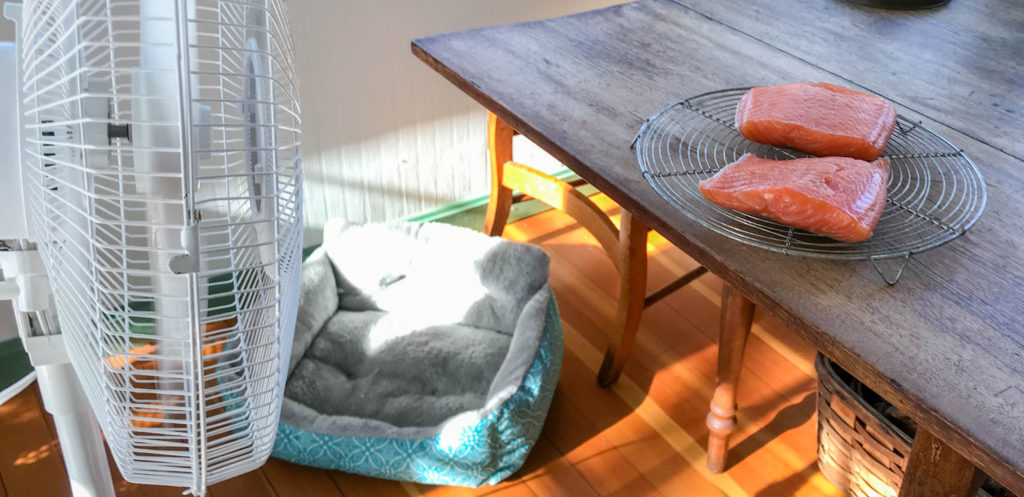
One more observation: people seem to be afraid of gravlax. It’s my most-requested recipe, and also the one that, when I ask folks later how it came out, they admit they never actually made. I attribute this to two things: an unacknowledged fear of slicing (we’ll address this later), and thinking of gravlax as a recipe, when it’s mainly a process.
So. Recipes are the least of your worries. With great fish, you could do fine with nothing but salt and time. So let’s look at this gravlaxing process in its most basic form.
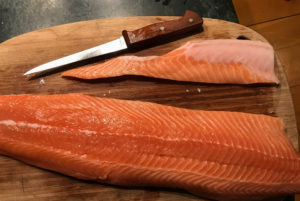
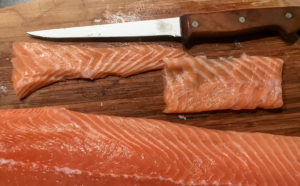
- You could get a chunk of a pound or two of salmon, but suppose you get a whole side? My fish guys sell it whole, so I cut off the belly flap, as shown. I might cook it up for our cat, Mingus, but he’s a kibble snob, so I’m likely to slice off the skin and the white membrane, roll it in brown sugar, and cook it a long time in a low oven (250 degrees for an hour or so) to make a few bites of salmon candy.
- Run your fingers against the grain of the fish (head to tail, in other words) and see if you feel any pin bones in that white center strip. The filleters sometimes leave a couple, and they’re annoying to deal with at slice time. Pull them out with needlenose pliers, in the direction they want to head.
- Rinse the fish in cold running water, to get rid of random scales and freshen it up. Pat dry with paper towels, both sides.
- Some recipes call for a bit of liquor – gin and tequila are great. I don’t know why people use vodka; it has almost no flavor. Mezcal is terrific, particularly if you’re going to smoke the fish afterwards. Scotch, rum and bourbon all go well with brown sugar. Aquavit, with its caraway flavor, is quite traditional, and presages the pumpernickel future. Sprinkle whatever it is on and rub it in lightly BEFORE you layer on salt, so it all hits the fish. A tablespoon is about enough for a small side, 2 or 3 pounds.
- Here’s a decision point: were you thinking of a lovely, clean presentation, or might your fish have fresh or dried herbs on it as you slice? If you’re keeping it clean, use only whole spices – black peppercorns, whole coriander seed, branches of dill you can easily remove – and lay them on with the salt. You will NOT want to rinse off bits of ground black pepper or chopped herbs before you serve. I doubt you even can; they tend to dig themselves in. On the other hand, a pastrami-type cure (as shown below) might call for a visible sprinkle on the edge of each slice. As with the booze, you’ll get more flavor if spices are applied directly to the fish – just keep in mind that they won’t all wipe off.
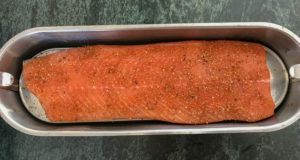
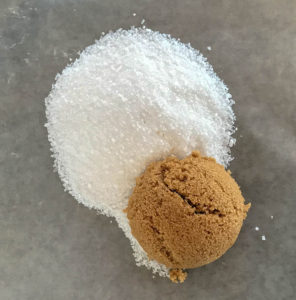
- Time to choose a receptacle. Do you actually own a salmon poacher? You’re either a true food nerd, British, hosted dinner parties in the seventies, or possibly all three. If the shoe fits, you have a perfect pan to cure a full side of salmon; one with it’s own weight distribution device.
- You could also try that parchment-and-sheet-pan trick (let me know how it turns out).
- Or, you could just find a baking pan that fits both the fish and your fridge. It doesn’t have to be that snug.
- Now it’s recipe time! Mix it up slavishly according to instructions, or just use, for each pound of fish, about 50 grams of kosher salt and 25 grams of sugar; brown or white. Weighing things is smart – did you know Morton’s salt weighs half again as much, by volume, as Diamond Crystal? – but I will not berate you if you use about 1/4 cup of salt and 2 T of sugar per pound of fish. Vary this as you like – sweeter, or with no sugar at all.
- Put about a third of the salt mix in your recipe in the bottom of the pan, then put the fish, skin side down, on top of the salt. Spread the rest of the salt mix evenly over the flesh of the fish, according to thickness. Give the thicker parts more salt.
- Flipping salmon every day is an affectation UNLESS (I almost forgot about this) you are following one of those (mostly older) recipes where you make a kind of salmon sandwich out of two roughly equal pieces with the flesh sides facing, and most of the salt in the middle. I expect that’s where the turning advice originated.
- Weighing salmon down is meh. I do it because I think it improves the texture, and it does squeeze out a bit more water in a shorter time.
- Do drain your fish at least once, after about 12 hours. Don’t let it wallow in its own brine. Not that it necessarily becomes inedible, but it adds a whole new variable you don’t want to worry about. Just remove the weights, peel back the covers in a corner, and drain it into the sink.
- Give it a peek after another twelve hours, or the next day. If the brine has accumulated to more than a film – really, if it rises up over the skin of the fish – drain it again. Same thing next day. Days four and on, you can probably just leave it alone, but you’re curious, aren’t you? Feel free to peek in and say hello.
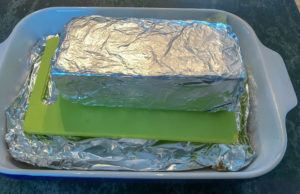
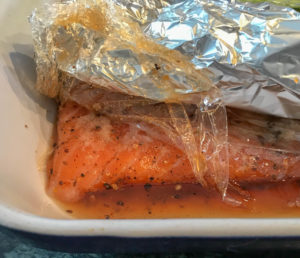
At this point, Eater, relax. Things will work out fine. Drain it as you can, move the brick around to keep the salmon evenly flat if that floats your boat (it will even out by itself once the weight is off for an hour or two), and make sure you have capers and red onion. You can even sprinkle on more salt if it’s looking naked on top, and you think you can get more water out of it.
Your gravlax will be ready to eat after 24 hours, if you like, but will continue to dry out for up to about 5 days. After that, rinse off the cure under running cold water as minimally as you can, and pat dry with paper towels. Lastly, for a nice finish, sprinkle on a bit more liquor and/or herbs if you were using them, then leave your salmon uncovered, overnight, in the fridge. The fish will dry out a bit more and form a slightly glossy, tacky surface known as a pellicle. This is an unskippable requirement for smoking – the pellicle helps the smoke particles adhere – but it also gives the fish some extra spoilage protection and a more finished look.
If you’d like to go on and cold-smoke the fish at this point, great. If not, well, there are plenty of places that would still call that lox. Most commercial smokehouses use big fans and very light smoke, to dry the fish out quickly and give it just a tiny bit of smoke flavor, which was traditionally considered inelegant. I often can’t smell it at all, which makes me wonder. When I do things at home, I like a medium smoke. My outdoor cooking sweatshirt, laundered or not, smells way smokier than most commercial lox.
It’s worth mentioning, at this point, that we’re only talking here about fish you will serve uncooked. Gravlax is either an end in itself, or a process that is finished off with a cold smoke that never heats the fish above about 80 degrees F. If your plan is to HOT smoke or maybe bake the fish later, well. You want something very different. You want a wet, salty brine that will pump moisture INTO your fish, so that it remains luscious after cooking. Hot smoking can easily turn salmon into jerky, but most modern recipes try for a fish you can still flake with a fork, as opposed to something you could hang from the rafters all winter.
Wrapped up tightly in plastic, gravlax will last at least a couple of weeks in the fridge; up to a month if it’s smoked. That’s why people cure things, after all – it makes food last longer. The bagel and cream cheese part is like friends with benefits. Add capers and some sliced red onion and, well – I can’t continue. I’m blushing.
